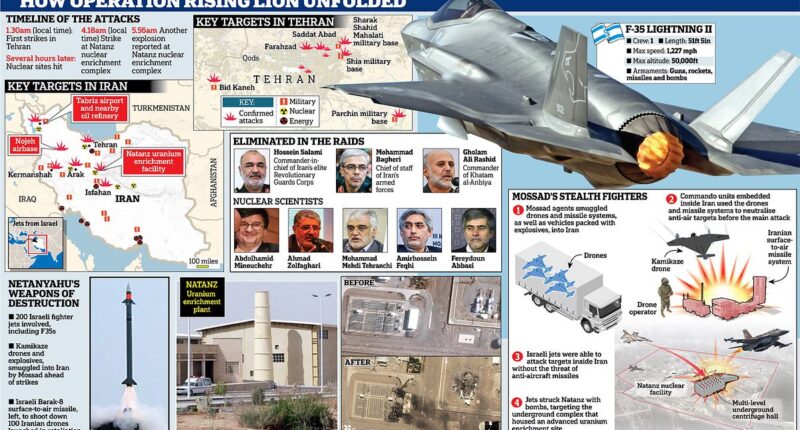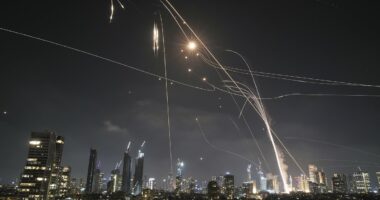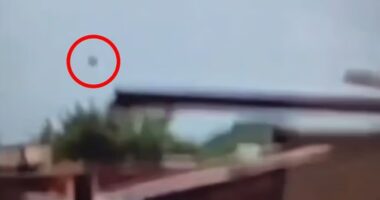Months, if not years in the planning, it was the most devastating attack on Iranian soil for nearly half a century.
A perfect fusion of high-grade conventional capabilities, human ingenuity and the latest advances in military technologies.
Result: Iran’s progress in nuclear enrichment was hindered, numerous air defense systems were destroyed, and key nuclear scientists and military leaders were eliminated.
Israel’s main objective was to weaken Iran’s nuclear enrichment abilities. However, there was also an underlying political motive as discussions about a potential regime change in Tehran started to surface.
Approximately at 1am UK time, around 200 Israeli military planes departed from bases located within the country. Nevertheless, a significant portion of the operation had been meticulously executed in complete secrecy prior to this deployment.
The ground had been laid some time ago by Mossad agents and Israeli special forces who infiltrated Iran, smuggled weapons into the country and prepared drones ahead of what Israel named Operation Rising Lion.
With only hours to go, the Israeli government informed the White House that the mission was going ahead, despite US and Iranian officials having arranged to hold talks on Sunday about descaling Iran’s nuclear-enrichment programme.

Extensive damage is seen in the Iranian capital, Tehran, after Israel conducted strikes

People look over damage to buildings in Nobonyad Square following Israeli airstrikes

Explained: The planning that went into Israel’s blitz which included smuggling drones into Iran dessert
This warning allowed US diplomats and their families posted to the region to take additional security precautions.
Donald Trump had previously indicated that while he was not prepared to assist Israel militarily, he would not stand in the country’s way either.
Israel’s hand was also strengthened by the announcement, only days earlier, by the United Nations’ nuclear watchdog that, for the first time in two decades, Iran was refusing to work with inspectors from the International Atomic Energy Agency.
Iran’s dismissive response to their pronouncement was to indicate it would establish a third nuclear-enrichment site and install more advanced centrifuges – a move which appeared to have sealed the country’s fate.
First reports of Israeli airstrikes emerged in northern Tehran: an explosion in the residential area of Nobonyad.
Details remained scant yesterday, but some reports indicated this may have been where some of the country’s leading nuclear scientists lived.
Subsequently, the Iranian government confirmed the deaths of a number of academics: Fereydoun Abbasi, former head of Iran’s Atomic Energy Organisation, Dr Mohammed Mehdi Tehranchi, president of the Islamic Azad University of Tehran, and Abdolhamid Minouchehr, Ahmad Zolfaghari and Amirhossein Feqhi, from Tehran’s Shahid Behesti University.

Israeli Prime Minister Benjamin Netanyahu gave the UK Prime Minister no notice of his plan

Keir Starmer described reports of the bombing raids as ‘concerning’ and urged all parties in the region to ‘step back and reduce tensions urgently’
Meanwhile, deep in the deserts of central and western Iran, Israeli special forces troops released swarms of drones which targeted radar facilities and surface-to-air missile capabilities – the military hardware an Iranian response to Israel’s attacks would rely on.
Israel is expert in such clandestine operations. Even so, the methodology represented a ‘hat-tip’ to Ukraine, which is understood to secretly exchange ‘tactics, techniques and procedures’ (TTPs), in military vernacular, with Israel.
The rationale for that cooperation from Israel’s perspective is it supports Ukraine – though it does not publicise that support – because Iran supplies Russia with thousands of drones.
With so many layers of Iran’s defences destroyed, Israeli jets focused on their main target, the centrepiece of Iran’s nuclear-enrichment programme, the Natanz atomic facility in Ishfahan province, 140 miles south of Tehran.
The IDF (Israel Defence Forces) and the International Atomic Energy Authority confirmed damage to the multi-storey enrichment hall where the nuclear centrifuges are housed.
Natanz has tens of thousands of centrifuges and significantly contributes towards Iran’s highly enriched uranium stockpile.
The IDF also targeted infrastructure at the site which, in its words, ‘enables the continuous functioning and the continued advancement of the Iranian regime’s project to obtain nuclear weapons’.
IDF spokesman Effie Defrin said its forces had ‘significantly harmed’ the site, which he added was used by the Islamic Revolutionary Guard Corps (IRGC) to ‘advance their military nuclear programme’.

Iranian President Masoud Pezeshkian (R) and Commander of the Islamic Revolutionary Guard Corps’ Aerospace Force Amir Ali Hajizadeh (C) in September 2024
Crucially, the Bushehr nuclear power plant was left unscathed. This ensured there was no increase in radiation levels.
This was by no means the first Israeli strike on Natanz.
It was the target of a major cyber attack in 2010 and a guerrilla-warfare style attack in 2020, when explosives were hidden inside one of the buildings.
As many as ten strikes were reported at Tabriz airport and a nearby oil refinery in north-west Iran. A long column of black smoke was seen rising from the airport. Three people were reported dead in the city itself.
Israel also struck dozens of radar installations in western Iran, probably by means of special forces troops approaching the sites on foot, assembling miniature kamikaze drones and setting them off towards these military facilities. Operating at such short range, these drones evaded Iran’s limited surveillance capabilities.
Explosions were also reported at the Nojeh airbase in Hamedan, western Iran. A number of senior Iranian military officers were also said to have been killed when they convened for what they thought was a secret meeting to plan pre-emptive strikes on Israel.
The venue was chosen for its protection, a bunker deep underground. But, according to reports, the bunker was not deep enough, as an Israeli warhead penetrated the basement.

Iranian air defense system glows over central Tehran, Iran as Israel launches air strikes

A general view of Tehran city as the air defense system intercepts fresh strikes, Iran, 13 June 2025

A damaged high-rise building that was hit by Israeli air strikes, north of Tehran, Iran, 13 June 2025
Iran later confirmed the deaths of Major General Gholam Ali Rashid, Major General Hossein Salami, commander of the IRGC, Amir Ali Hajizadeh, the commander of the UAV (unmanned aerial vehicles) force, aerial commander Davoud Shaykhian and Mohammad Bagheri, the Iranian Army’s Chief of Staff.
As precautionary measures, Israel closed its airspace and its diplomatic missions overseas. It also suspended gas production at sites in the Mediterranean.
Meanwhile its attacks across Iran lasted for at least five hours – possibly much longer as reports last night suggested that, having secured aerial supremacy, Israeli jets were returning to some of the targets to inflict further damage.
By way of response, Iran is said to have launched at least 100 drones towards Israel. Its officials also declared the attacks ‘declaration of war’.
Iranian drones were found on the ground in Syria after being intercepted by the Israelis.
The IDF also released footage of the country’s navy shooting down an Iranian drone using Barak-8 surface-to-air missile.
That no Iranian ordnance seemingly struck any Israeli targets may have convinced its state news agency Fars to deny it had launched any drones at all, claiming Iran’s revenge will ‘take place in the near future’. Iranian media also reported at least 78 deaths and 329 casualties from the Israeli attacks, including women and children.
Iran’s Supreme Leader Ayatollah Ali Khamenei said Israel should ‘anticipate a severe punishment’, adding the country’s armed forces would defend Iran’s sovereignty.
To the surprise of Western observers, Iran’s most loyal proxy group in the region, Hezbollah, which is based in Lebanon and armed and financed by Iran, said it would not respond.
Iran halted all domestic and international flights from its airspace.
US Secretary of State Mark Rubio suggested Israel’s actions were ‘unilateral’.
While the US did not take part in the military action it was fully aware of Israel’s intention.
Sir Keir Starmer, sidelined by Israel after condemnation of its continuing campaign in Gaza, called for de-escalation. A No 10 spokesman said: ‘Our priority is to prevent further escalation in the Middle East, that’s in no one’s interest… we’re working closely with all our allies to press for that diplomatic solution’.
Russia, which recently signed a military cooperation pact with Iran, condemned Israel’s ‘unprovoked attack on a sovereign state’. While China expressed ‘concern’. So did Saudi Arabia and Qatar.
Israeli prime minister Benjamin Netanyahu was last night due to speak to Vladimir Putin.
UN secretary general Antonio Guterres asked both sides to ‘show maximum restraint, avoiding at all costs a deeper conflict’.
Mr Trump advised Iran to ‘make a deal’ while it still has the opportunity. He described Israel’s attack as ‘excellent’. Israel has claimed it was ‘just the beginning’.
The UN Security Council was meeting yesterday to discuss the continuing crisis.
Mr Netanyahu was expected to speak to Sir Keir. The Prime Minister has also discussed the Middle East security crisis with German chancellor Friedrich Merz and French president Emmanuel Macron.

















